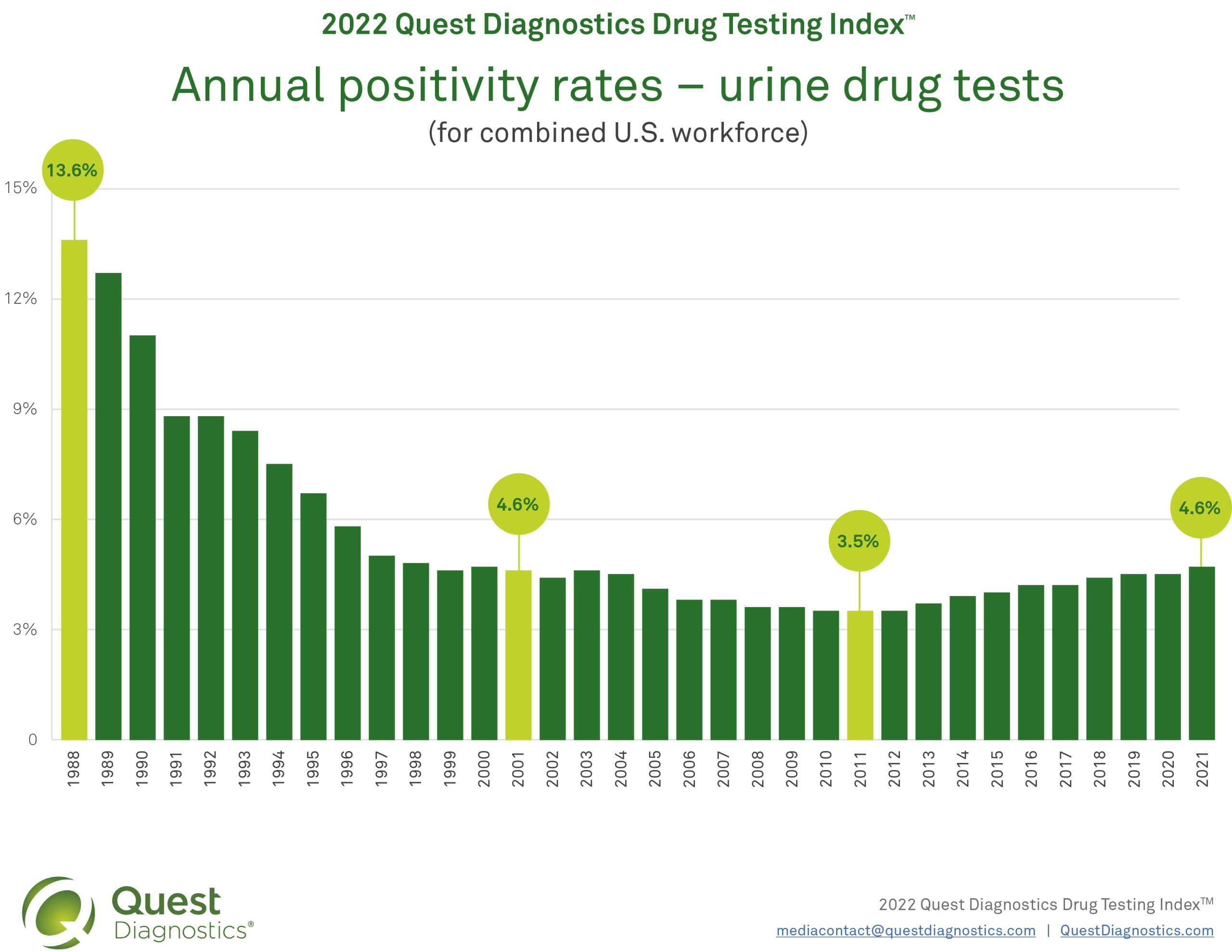Number of Positive Drug Tests Highest Since 2001
Positives grew 31.4% in the last decade.
From Quest Diagnostics.

The rate of positive drug tests among the U.S. workforce last year reached its highest rate since 2001 and was up more than 30% from its all-time low in 2012, according to analysis released by Quest Diagnostics, a provider of diagnostic information services.
The study, based on more than 11 million urine, hair, and oral fluid drug-test results collected between January and December 2021, offers revealing insights into workforce drug use as employers grapple with creating safe, healthful work environments amid an ongoing recruitment and retention crisis.
The overall positivity rate in the combined U.S. workforce, based on nearly nine million urine drug tests collected between January and December 2021, was 4.6%, up from 4.4% in 2020. The 2021 positivity rate rose 31.4% from the all-time low of 3.5% just 10 years ago.
The combined U.S. workforce includes the general U.S. workforce of mostly company-policy testing by private employers as well as the federally mandated, safety-sensitive workforce, which includes federal employees and the transportation and nuclear power industries, and can include workers such as pilots, truck drivers, train conductors, and others required to drug test under federal legislation.

“Employers are wrestling with significant recruitment and retention challenges as well as with maintaining safe and engaging work environments that foster positive mental and physical well-being,” said Keith Ward, general manager and vice president of Quest Diagnostics Employer Solutions. “Our Drug Testing Index data raises important questions about what it means to be an employer committed to employee health and safety. Eager to attract talent, employers may be tempted to lower their standards. In the process, they raise the specter of more drug-related impairment and worksite accidents that put other employees and the general public in harms’ way.”
Overall positivity in the federally mandated, safety-sensitive workforce based on nearly 2.7 million urine drug tests stayed even year over year, at 2.2% in 2020 and 2021. It was 4.8% higher than 2017. In the general U.S. workforce, positivity increased 1.8% since 2021 and was 12% higher than in 2017, up each of the last five years.
After five years of steady declines in several drug categories, positivity rates based on urine drug tests for the federally mandated, safety-sensitive workforce increased in 2021. Of note, marijuana increased 8.9%, amphetamines increased 7.8%, and cocaine increased 5.0%.
Highest ever positives for marijuana
Positivity rates for marijuana in the general U.S. workforce, based on more than 6 million urine tests, continued an upward climb, increasing 8.3% over 2021, the highest positivity rate ever reported in the DTI. Over five years, positivity for marijuana in the general U.S. workforce increased 50% since 2017.
In 2021, positivity in the general U.S. workforce based on oral fluid was 7.3% in 2021, a decline of 46.3% compared to 2020 and 29.8% compared to 2017. The drop in oral fluid-positivity was driven by a decline in the number of pre-employment tests that included marijuana. However, for those tests that included marijuana, the oral-fluid drug positivity rate for marijuana was 14.8% in 2021, an increase of 20.3% compared to 2020 and up 68.2% since 2017. At the same time, the positivity rate for cocaine increased 46.6%, its highest spike since 2006, and methamphetamine increased 26.4%, exhibiting year-over-year increases for the last five years.
Oral fluid tests generally have a shorter window of drug detection than urine. They can detect some drugs faster, in a matter of minutes versus hours. Oral fluid collection also has the advantage of being observed, making it harder to subvert the testing process.
Positivity for cocaine based on urine tests in the general U.S. workforce decreased 4.5% and positivity for cocaine over the past five years declined 30%. Positivity rates for cocaine based on urine tests in the federally mandated safety, safety-sensitive workforce increased 5.0%, the first increase in five years.
Positive tests for opiates down
Positivity for opiates (codeine/morphine) based on urine drug tests in the general U.S. workforce decreased 19% over 2020 and 56.4% since 2017. Positivity for opiates (hydrocodone/hydromorphone) in the general U.S. workforce decreased 3% and 37.3% over five years. Positivity for oxycodones (oxycodone/oxymorphone) in the general U.S. workforce stayed the same in 2020 and 2021 and decreased 52.5% over five years.
Positivity for heroin based on urine tests in the general U.S. workforce decreased 27.8% and 56.7% over five years. Positivity for heroin in the federally mandated, safety-sensitive workforce decreased 37.5% and 73.7% over five years.
For more information, visit www.QuestDiagnostics.com.






